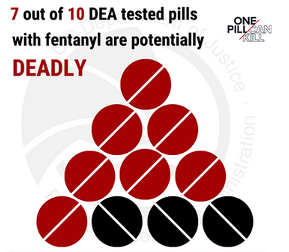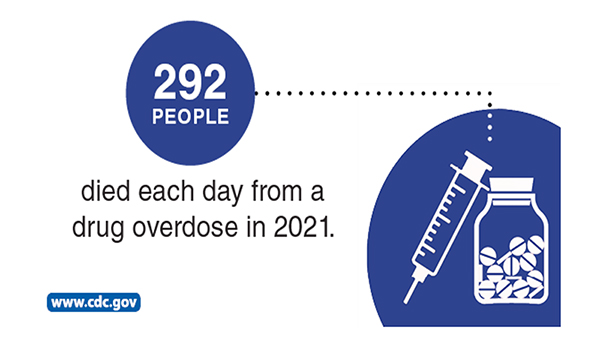Fentanyl
Fentanyl is the strongest opioid, and it is the one that is killing people who unknowingly ingest it. Just a few grains of it, placed in any substance, can be fatal. Very often, a person who thinks they are taking a recreational substance can experience a deadly fentanyl poisoning.
Fentanyl may be more common than you think.
According to the U.S. Drug Enforcement Administration (DEA), 42% of all counterfeit pills tested contained a potentially lethal dose of fentanyl. A lethal dose of fentanyl can be as little as 2 mg, depending on a person’s body size, tolerance and past usage--that's a fraction of raindrop or a few grains of salt.

Where is Fentanyl Found?
Fentanyl can be found in non-prescription substances purchased anywhere other than a pharmacy. Drug traffickers often mix fentanyl into other drugs because it’s cheaper to produce a high with fentanyl. Fentanyl can take the form of a powder, a capsule, or can be pressed into counterfeit pills that are made to look like prescription opioids, such as oxycodone (Oxycontin®, Percocet®) and hydrocodone (Vicodin®); alprazolam (Xanax®); or stimulants like amphetamines (Adderall®). Where else might you find fentanyl?
- Fentanyl is sometimes mixed in with heroin but is much more potent.
- Meth and cocaine are sometimes cut with fentanyl to reduce the cost of production.
- Many drug suppliers mix fentanyl with meth or oxy, and then add red, yellow or blue food coloring to form a pill sold as MDMA, or ecstasy.
As a result, people who use drugs can easily and unknowingly ingest a lethal dose of fentanyl.
Note: Free Fentanyl and Xylazine test strips are available in the Wellness Pantry outside of Student Health Services
Understand the risk
Fentanyl is a powerful synthetic opioid that is similar to morphine but is 50 to 100 times more potent. Synthetic opioids, including fentanyl, are now the most common drugs involved in drug overdose deaths in the United States.

Overdose Prevention training (Narcan Training) is available to all students, faculty and staff. If you're interested in a naloxone training for your department or organization, contact Bridget at (315) 267-3676 or bradisba@potsdam.edu.
St. Lawrence County
- NYS Opiod Data Dashboard (select St. Lawrence County from dropdown menu)
New York State
- CDC Overdose Statistics
- Non-fatal fentanyl overdose statistics - New York: 11,491
- Annual number of nonfatal opioid overdose emergency department (ED) visits in 2021 - New York: 4,107
National Statistics
- CDC
- 15 to 24 years old ER visits
- Female: 4,481
- Male: 8,137
- 2021 Deaths for 15 to 24 year olds
- Female: 1,010
- Male: 2,237
- Take medicine as prescribed by your practitioner.
- Do not take more medication or take it more often than instructed.
- Never mix pain medicines with alcohol, sleeping pills, or illicit. substances. Using different drugs together, including alcohol, increases your risk of overdose.
- Never take anyone else’s medication.
- Prevent children and pets from accidental ingestion by storing your medication out of reach.
- Dispose of unused medication safely.
- Do not use any substances when you are alone. Identify someone who remains sober and can monitor your safety if you are under the influence.
- Get naloxone. Naloxone is an emergency medication that can reverse an overdose from heroin and other opioids, including fentanyl. When you use substances, leave naloxone out where others can find it.
- If you’ve used fentanyl or other substances in the past but have recently been sober, your tolerance for the drug has likely decreased. If you choose to use again, be mindful of potential changes in drug potency and start with a smaller dose than you might have used in the past.
- Test the substance using fentanyl test strips.
